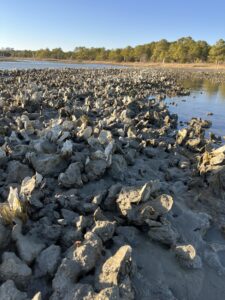
You could say it takes a village to raise a Lynnhaven oyster.
The iconic oyster is flourishing on the river, thanks to sanctuary reefs like LRNow’s beautiful Pleasure House Creek reef, above, because of a village of helpers.
Whether it is your support for LRNow at Saturday’s Oyster Roast and in other ways, or whether it is those of you who deliver oyster shells to our Save Our Shell collection centers and the businesses who support SOS, or whether it is students who help build oyster cages, or homeowners who raise baby oysters in those cages, it takes a village.
Last week baby oyster raisers were front and center. These homeowners from all over the Lynnhaven River volunteer to hang small cages of shell off their piers for about a year to see how many little oyster larvae floating around in the river are attracted to settle and attach to the shell. There, the little spat, as they are called, can grow into adult oysters.
These good folks, cages in hand, arrived at the Brock Center to see what a year had wrought. The cages were not only full of baby spat but also sea squirts, tiny fish, crabs and other critters who love living on an oyster reef.

Not only does this yearly count, which has been going on for about a decade, tell LRNow what areas of the river produce the most oysters, but also what substrates, or materials, other than scarce oyster shells, that baby spat are most apt to settle on to grow up.
This year the spat raisers tested cages filled with oyster shells and whelk shells for comparison.
Oyster raisers included Pamela Bowhers on the Western Branch and Chris Boehme from Birdneck Point as well as new oyster raiser Laura Frank from Baycliff who picked up cages for the first time.
“I’m excited to try it,” said Laura. “It’s like a science experiment!”
On the other hand, Chris and Pamela were more interested in how their counts compared to last year’s. There was even a pizza bet between Pamela and her neighbor, also an oyster raiser, as to who would have the most baby spat this year.
Oyster Restoration Manager Brent James counted the spat–tiny, almost flat, white round shapes–on each shell. Cristin Pullman, Community Outreach Manager, recorded the spat count and how many were on which substrate.

The oyster growers took home new cages to hang from their piers. One cage, as always, was filled with oyster shells and this year, the other with mussel shells.
After counting Brent took the shells with spat to help seed LRNow’s restoration reef, such as the one at Pleasure House Creek.
This reef, easily visible on a low tide from the trail at Pleasure House Point, is a great example of the collective effort of our village. In just four years, 20 to 25 millions oysters live there filtering the water and keeping the river healthy for all oysters and critters out there to thrive.
“It’s a tremendous success,” Brent said.
Walk the trail on a low tide day and see this tremendous success our village created.
Become a part of our village and attend the oyster roast Saturday here or read more about becoming an oyster raiser here.
